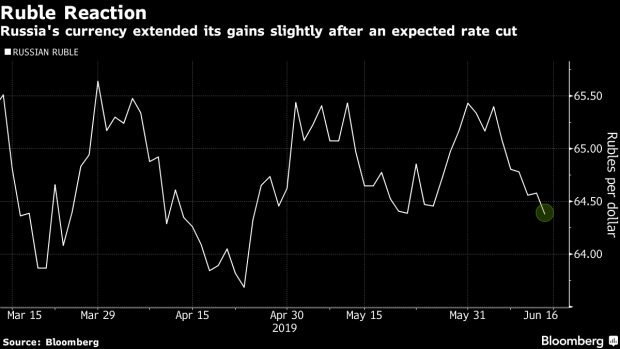Jun 16, 2019
Ruble Traders Greet the Doves as Russia Returns to Rate-Cut Path
, Bloomberg News

(Bloomberg) -- Russia joined a growing pack of emerging-market nations lowering interest rates and signaled more reductions to come, boosting bonds and the ruble and leaving traders to guess the timing of its next cut.
The ruble was one of only a few developing-nation currencies to strengthen on Friday, climbing as much as 0.6% after central-bank Governor Elvira Nabiullina said two more cuts were possible this year. Bonds extended their rally, leaving 10-year yields down about 25 basis points in the month so far.
The first reduction in more than a year had been expected and strategists said Bank of Russia’s dovish tone was justified given weak growth and slowing in inflation, meaning further cuts wouldn’t hurt the world’s best-performing currency this year. With the Federal Reserve predicted to lower rates in the U.S., Russia’s carry-trade appeal should endure, ensuring further flows into the nation’s bonds.
Read More: Bank of Russia Cuts End-2019 Inflation Outlook to 4.2%-4.7%
Here’s what analysts are forecasting after Friday’s quarter-point cut:
Piotr Matys, currency strategist at Rabobank in London
- “Nabiullina has been unusually very explicit by saying that two more rate cuts are possible in the second half of the year”
- “Lowering interest rates gradually by the Bank of Russia should not hurt the ruble significantly after major central banks turned decisively dovish and the Fed is expected to cut rates”
- “Even if the Bank of Russia cuts on two more occasions this year, the ruble will remain one of the highest-yielding emerging-market currencies”
Dmitry Dolgin, chief economist at ING Groep NV in Moscow
- “The current dovishness is justified, and in Russia’s case this still means positive real rates. In this context, a lower nominal rate creates expectations of higher OFZ prices which attracts foreign capital, eventually leading to a stronger ruble”
- ING is predicting rate cuts at the central bank’s July and September meetings
Vladimir Miklashevsky, a strategist at Danske Bank A/S in Helsinki
- “The central bank definitely wanted to signal that it is joining the global monetary easing trend”
- Friday’s “decision fortifies our call of two more 25 basis-point cuts in 2019, making possible a total 100 basis-point decrease in the key rate on 12 month horizon to 6.50%, if the current conditions hold”
- “The ruble just loves the doves, and we see more flows into OFZs given the current rate and inflation outlook, lack of news on new anti-Russia sanctions”
Per Hammarlund, chief emerging-markets strategist at Skandinaviska Enskilda Banken AB
- “The dovish stance taken by the central bank is consistent with inflation trending down from here and with no major worries that the Bank of Russia would cut too fast, the ruble will not move much”
- “Even with further interest-rate cuts on the horizon, Russian yields are still very attractive, due to the government’s strong credit profile, which will keep capital flowing into Russian markets”
- “The ruble will trade primarily on changes in oil prices, although it will not be as volatile as it was before the introduction of the current fiscal rule”
Natalia Orlova, analyst at Alfa-Bank in Moscow
- “Concerns over growth is the key reason pushing the central bank to act”
- “At the moment, the 1.3% cabinet growth target for this year looks being at risk, the central bank is acting to prevent being blamed for the poor growth result”
--With assistance from Kira Zavyalova.
To contact the reporter on this story: Áine Quinn in London at aquinn38@bloomberg.net
To contact the editors responsible for this story: Dana El Baltaji at delbaltaji@bloomberg.net, Alex Nicholson, Srinivasan Sivabalan
©2019 Bloomberg L.P.


